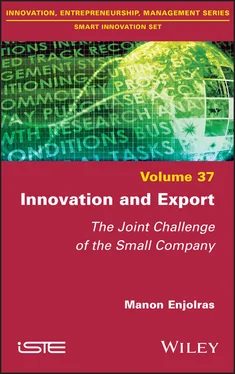By way of summary, given the context of innovation and export in SMEs, three observations can be made:
– the first concerns the limited performance of SMEs on international markets and their difficulty in setting up a successful innovation process. This can be explained by a preponderant constraint directly linked to their small size: the lack of resources and the difficulty to put in place the right conditions to exploit them. Thus, SMEs wishing to progress must structure their internal processes, prioritize their actions and identify adequate improvement levers in view of the means they can mobilize;
– the second observation concerns the incentive nature of the support offered to SMEs. The schemes mostly offer financial support or information, which appears to be one-off assistance rather than real long-term support. It, therefore, seems necessary to offer support based on individual advice, allowing the company’s organization to be modified by changing the practices and activities in place, and thus offering more sustainable support;
– the third observation concerns the link between innovation and export. In the scientific literature, this link has traditionally been considered in the form of a cause-and-effect relationship. However, a paradigm shift seems to be emerging, highlighting the need to propose an approach that breaks with this causal vision in order to take into account the complementarity that exists between innovation and export. It is a question of considering these two activities together and not in terms of the impact of one on the other.
Thus, through this research work, we propose considering the relationship between innovation and export from an original angle. The objective is to formalize the innovation–export relationship in SMEs through the complexity paradigm (Morin 1977). This formalization leads to the identification and characterization of a common conceptual space between innovation and export capabilities. This common space gathers the joint innovation–export activities that an SME must develop in order to simultaneously progress in terms of innovation and export. It, therefore, represents a priority area for action to be promoted among companies in order to encourage them to modify their internal practices to exploit synergies and thus optimize the mobilization of their resources. From an operational point of view, the valorization of this common space requires the proposal of a support tool to evaluate the degree of mastery of the companies concerning the practices, resources and competencies that make up this common space. The first objective of this diagnostic tool is to draw up a profile of the companies evaluated in order to identify the activities they need to develop as a priority in order to successfully complete their export and/or innovation process. The second objective is to propose personalized recommendations based on their strategy to promote the emergence of innovation–export synergies. The implementation of these recommendations allows the company to progress both in terms of innovation and export, relying on synergies to mobilize its resources in an adequate and optimized way.
The ambition of this book is, therefore, to support a joint and complex vision of innovation and export in SMEs and to apply it to the problem of the business world. Initiated in 2013, through a thesis (Enjolras 2016), the work carried out is part of the PRINCIP research chair (research cluster on innovation and SMEs’ innovation capability) at the University of Lorraine and was conducted in collaboration with the IDEFI InnovENT-E project (initiative of excellence in innovative training). This research work is also a multidisciplinary initiative between industrial engineering and management sciences, promoting the need for an alliance between the creation of representation frameworks to share vision and meaning (scientific approach specific to management sciences, based on value creation and a cognitive approach to individuals and situations) and access to modeling formalisms from complex systems (a scientific approach specific to engineering sciences that favors instrumental development). Thus, this work exploits the strength of this multidisciplinarity combined with a strong field vision provided by numerous partners from the regional SME ecosystem. They have indeed several academic, industrial and institutional forms of support (UIMM 4, F2I 5, CNRS University of Lorraine 6, Lorraine University of Excellence initiative of the PIA2 7, Lorraine Regional Council, etc.). This book presents the results of this work in order to promote a joint vision of innovation and export, as well as the exploitation of the resulting synergies among both SMEs and institutional support actors. Through the design of a multi-criteria decision support tool aimed at highlighting these synergies, this work proposes a concrete application of this joint vision and its contributions, particularly in terms of resource optimization, which is a particularly crucial issue for SMEs.
The book is composed of five chapters divided into two complementary parts. The first part exposes and justifies the scientific positioning of the research. It, therefore, approaches the problem of innovation and export in SMEs from a theoretical point of view. Chapter 1aims to introduce and relate the main concepts mobilized in order to arrive at a robust theoretical framework. This chapter thus proposes an original vision of the innovation–export relationship by applying the complexity paradigm. The main result of this chapter is the identification of a common innovation–export space at the origin of synergies. Chapter 2aims to define and characterize the common innovation–export space through the identification of joint activities. It, therefore, presents the process of identifying activities specific to innovation and those specific to export before describing the identification and characterization of joint innovation–export activities that enable SMEs to simultaneously improve their ability to innovate and export.
The second part adopts a more operational stance by seeking to transform the theoretical common space into a repository of joint practices at the origin of a functional decision support tool. The aim is to exploit the conceptual results of Part 1to give them substance through the development of an evaluation tool ( Chapter 3), and then applied through six case studies ( Chapter 4). The tool, called “PE2I” (Potential Export and Innovation Index), was thus designed and tested with six French SMEs, from manufacturing or process sectors, of different sizes and technological intensity. This section provides feedback on the evaluation tool, its implementation and the performance of its results in order to identify prospects for improvement ( Chapter 5).
1 1 As defined by the OECD TEC (Trade by Enterprise Characteristics) database: microenterprises: <10 employees; small enterprises: 10–49 employees; medium enterprises: 50–249 employees; large enterprises: >250 employees.
2 2 The gap between micro and small enterprises is explained by the fact that the majority of microenterprises are not export-oriented, due to their specific activities (local services, for example).
3 3 In this book, we use the definition of innovation supported by ISO 56002 (2019): a new or changed product, service, process, business model or organization.
4 4 Union des industries et métiers de la métallurgie, French Union of Metallurgical Industries and Trades.
5 5 Fond pour l’innovation dans l’industrie, Fund for innovation in industry.
6 6 Primary Support Exploratory Projects (Projets exploratoires premier soutien, PEPS) to foster interdisciplinary exploratory research.
7 7 Plan d’investissement d’avenir 2 de l’ANR Lorraine université d’excellence, reference ANR-15-IDEX-04-LUE.
Читать дальше












